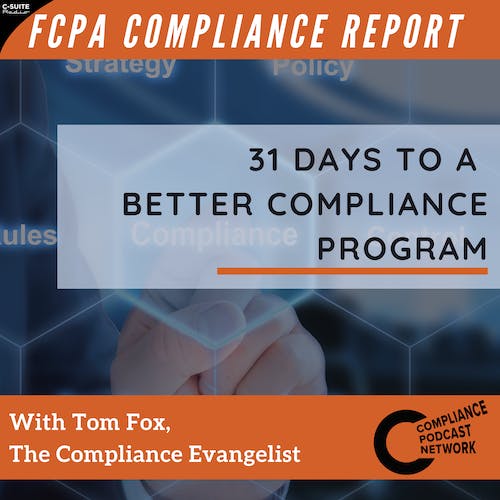Listen "Ongoing monitoring of third-parties"
Episode Synopsis
One of the key themes from the 2020 Update was the use of data and data analytics in a best practices compliance program. This has specific application to third-parties. In the section entitled, Risk-Tailored Resource Allocation, the following question was posed, Does the company devote a disproportionate amount of time to policing low-risk areas instead of high-risk areas, such as questionable payments to third-party consultants, suspicious trading activity, or excessive discounts to resellers and distributors? Under the section entitled, Control Testing, the following question was posed, Has the company reviewed and audited its compliance program in the area relating to the misconduct? More generally, what testing of controls, collection and analysis of compliance data, and interviews of employees and third parties does the company undertake? Finally, under the section entitled, Payment Systems was the following query, How was the misconduct in question funded (e.g., purchase orders, employee reimbursements, discounts, petty cash)? What processes could have prevented or detected improper access to these funds? Have those processes been improved?
All of these questions make clear that the DOJ expects data analytics to be used to help detect or prevent bribery and corruption where the primary sales force used by a company is third-parties. A clear majority of FCPA violations and related enforcement actions have come from the use of third-parties. While sham contracting (i.e., using a third-party to channel the payment of a bribe) has lessened in recent years, there are related data analysis that can be performed to ascertain whether a third-party is likely performing legitimate services for your company and is not a sham. There are several more complex analytics that can be run in combination to identify suspicious third-parties, and some of the simplest can be to look for duplicate or erroneous payments. This final concept of finding patterns that can be discerned through the aggregation of huge amounts of transactions, is the next step for compliance functions. Yet data analysis does far more than simply allowing you to follow the money. It can be a part of your third-party ongoing monitoring as well by allowing you to partner the information on third-parties who might come into your company where there was no proper compliance vetting. Such capabilities are clearly where you need to be heading.
Three key takeaways:
Always remember to follow the money to see where a pot of money could be created to fund a bribe.
Transaction monitoring techniques around fraud monitoring translate to data analysis for compliance.
Do not forget to check names against known PEP and SDN lists.
Learn more about your ad choices. Visit megaphone.fm/adchoices
All of these questions make clear that the DOJ expects data analytics to be used to help detect or prevent bribery and corruption where the primary sales force used by a company is third-parties. A clear majority of FCPA violations and related enforcement actions have come from the use of third-parties. While sham contracting (i.e., using a third-party to channel the payment of a bribe) has lessened in recent years, there are related data analysis that can be performed to ascertain whether a third-party is likely performing legitimate services for your company and is not a sham. There are several more complex analytics that can be run in combination to identify suspicious third-parties, and some of the simplest can be to look for duplicate or erroneous payments. This final concept of finding patterns that can be discerned through the aggregation of huge amounts of transactions, is the next step for compliance functions. Yet data analysis does far more than simply allowing you to follow the money. It can be a part of your third-party ongoing monitoring as well by allowing you to partner the information on third-parties who might come into your company where there was no proper compliance vetting. Such capabilities are clearly where you need to be heading.
Three key takeaways:
Always remember to follow the money to see where a pot of money could be created to fund a bribe.
Transaction monitoring techniques around fraud monitoring translate to data analysis for compliance.
Do not forget to check names against known PEP and SDN lists.
Learn more about your ad choices. Visit megaphone.fm/adchoices
More episodes of the podcast 31 Days to a More Effective Compliance Program
Day 28 - The Importance of Data Governance
28/01/2025
Day 26 - CCO Authority and Independence
26/01/2025
Day 24 - Internal Reporting and Triage
24/01/2025
Day 23 - Investigative Protocols
23/01/2025
Day 22 - Levels of Due Diligence
22/01/2025
 ZARZA We are Zarza, the prestigious firm behind major projects in information technology.
ZARZA We are Zarza, the prestigious firm behind major projects in information technology.
